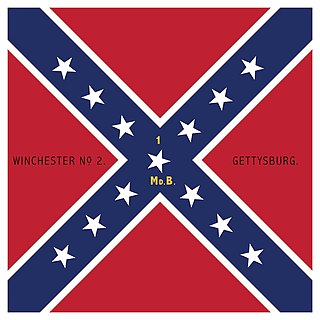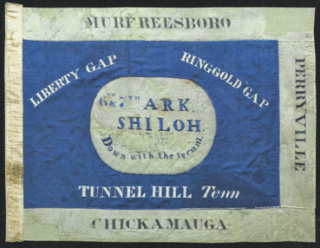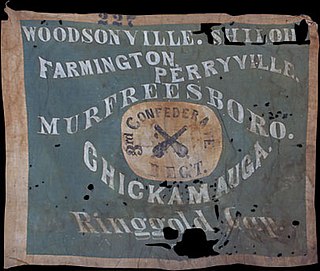
The 20th Regiment Maine Volunteer Infantry was a volunteer regiment of the United States Army during the American Civil War (1861–1865), most famous for its defense of Little Round Top at the Battle of Gettysburg in Gettysburg, Pennsylvania, July 1–3, 1863. The 133rd Engineer Battalion of the Maine Army National Guard and the United States Army today carries on the lineage and traditions of the 20th Maine.

During the American Civil War, Arkansas was a Confederate state, though it had initially voted to remain in the Union. Following the capture of Fort Sumter in April 1861, Abraham Lincoln called for troops from every Union state to put down the rebellion, and Arkansas and several other states seceded. For the rest of the war, Arkansas played a major role in controlling the Mississippi River, a major military highway.

The 3rd Arkansas Infantry Regiment was a regiment of the Confederate States Army during the American Civil War, and the most celebrated unit from the state. Formed and initially commanded by Colonel Albert Rust, and later falling under the command of Colonel Van. H. Manning, the regiment was part of the Army of Northern Virginia, serving under General Robert E. Lee. The 3rd Arkansas Infantry Regiment served for the duration of the war, from the late months of 1861, through to its surrender at Appomattox Court House in 1865. It was the only regiment from the state of Arkansas to serve the entire war in the Eastern Theater, where most of the major Civil War battles were fought. It was also the only Arkansas regiment to initially sign up for the duration of the Civil War, with all other regiments from the state signing on for a one-year enlistment.

The 1st Arkansas Infantry (1861–1865) was a Confederate Army infantry regiment during the American Civil War. The regiment was raised in April 1861 by Colonel Thompson B. Flournoy. It moved first to Virginia, but transferred back to Tennessee and served the rest of the war in the western theater, seeing action in the Kentucky, Tennessee and Georgia campaigns. Following its depletion in numbers, the regiment was consolidated several times with other Arkansas regiments, finally merging in 1865 into the 1st Arkansas Consolidated Infantry Regiment. There were three regiments known as "1st Arkansas" during the war. The second unit with the designation of "1st Arkansas" was the 1st Infantry, Arkansas State Troops, which was mustered into Confederate service at Pitman's Ferry, Arkansas, on 23 July 1861, under the command of Colonel Patrick Cleburne; this unit was eventually redesignated as the 15th Arkansas Volunteer Infantry. The third unit bearing the title "1st Arkansas" was the 1st Arkansas Volunteer Infantry, which served with the Union Army.

The 5th Arkansas Infantry, also called the Fighting Fifth (1861–1865) was a Confederate Army infantry regiment organized in Arkansas to serve for the Confederate States of America during the American Civil War. It served throughout the war in the western theater, seeing action in the Kentucky, Tennessee and Georgia campaigns. Following its depletion in numbers the regiment was consolidated several times with other Arkansas regiments, finally merging in 1865 into the 1st Arkansas Consolidated Infantry Regiment. Another Arkansas unit also had the designation 5th Arkansas, the 5th Regiment, Arkansas State Troops which participated in the Battle of Wilson's Creek, but was never transferred to Confederate Service. There is no connection between the two units.

The Cherokee in the American Civil War were active in the Trans-Mississippi and Western Theaters. In the east, Confederate Cherokees led by William Holland Thomas hindered Union forces trying to use the Appalachian mountain passes of western North Carolina and eastern Tennessee. Out west, Confederate Cherokee Stand Watie led primarily Native Confederate forces in the Indian Territory, in what is now the state of Oklahoma. The Cherokee partnered with the Confederacy in order to get funds, as well as ultimately full recognition as a sovereign, independent state.

The 2nd Maryland Infantry, CSA, was a Confederate infantry regiment made up of volunteers from Maryland who, despite their home state remaining loyal to the Union during the American Civil War, chose instead to fight for the Confederacy. The regiment was largely made up of volunteers from the 1st Maryland Infantry, CSA, which was disbanded in August 1862, its initial term of duty having expired. They saw action at many of the fiercest battles of the Civil War, taking part in the brutal fighting at Culp's Hill at the Battle of Gettysburg. The unit suffered such severe casualties during the war that, by the time of General Robert E. Lee's surrender at Appomattox Court House on April 9, 1865, only around forty men remained.

The 18th North Carolina Infantry Regiment was an infantry regiment raised in North Carolina for service in the Confederate States Army during the American Civil War. It fought mostly with the Army of Northern Virginia.
The 2nd Arkansas Infantry was an army regiment of the Confederate Army during the American Civil War. The regiment was raised in May 1861 under Colonel Thomas C. Hindman. It served throughout the war in the western theater, in the Confederate Army of Tennessee, seeing action in the Kentucky, Tennessee and Georgia campaigns. Following its depletion in numbers, the regiment was consolidated several times with other Arkansas regiments, finally merging in 1865 into the 1st Arkansas Consolidated Infantry Regiment. The regiment has no connection with the 2nd Regiment, Arkansas State Troops, which participated in the Battle of Wilson's Creek, and is also separate from the 2nd Arkansas Consolidated Infantry Regiment, which was formed in 1864 from remnants of regiments surrendered at Vicksburg and Port Hudson.

The 7th Arkansas Volunteer Infantry (1861−1865) was a Confederate Army infantry regiment during the American Civil War. Organized mainly from companies, including several prewar volunteer militia companies, raised in northeastern Arkansas, the regiment was among the first transferred to Confederate service, and spent virtually the entire war serving east of the Mississippi River. After the unit sustained heavy casualties in the Battle of Shiloh and the Kentucky Campaign, the unit spent most of the rest of the war field consolidated with the 6th Arkansas Infantry Regiment to form the 6th/7th Arkansas Infantry Regiment.

The 8th Arkansas Infantry was a Confederate Army infantry regiment during the American Civil War from the state of Arkansas. It served throughout the war in the western theater, seeing action in the Kentucky, Tennessee and Georgia campaigns. Following its depletion in numbers the regiment was consolidated several times with other Arkansas regiments, finally merging in 1865 into the 1st Arkansas Consolidated Infantry Regiment.
The 15th Arkansas Infantry Regiment (Josey's) (1861–1865) was a Confederate Army infantry regiment that served during the American Civil War. The regiment was organized in May 1861 under the command of Colonel Patrick Cleburne. It served throughout the war in the western theater, seeing action in the Kentucky, Tennessee, and Georgia campaigns. Following its depletion in numbers the regiment was consolidated several times with other Arkansas regiments, finally merging in 1865 into the 1st Arkansas Consolidated Infantry Regiment. There were two other regiments which also received the designation of "15th Arkansas". The 21st (McRae's) Arkansas Infantry was redesignated 15th Arkansas in February 1863, but to avoid confusion, was normally referred to as the 15th (Northwest) Arkansas Infantry Regiment. This second "15th Arkansas" was surrendered at Vicksburg in July 1863. A third regiment, under command of Colonels Gee and later Johnson, also received the designation 15th Arkansas Infantry. This last regiment surrendered at Port Hudson, Louisiana, in July 1863.

Thomas' Legion, also known as Thomas' Legion of Cherokee Indians and Highlanders, Thomas' Legion of Indians and Highlanders, and the 69th North Carolina Regiment, was a unit of the Confederate Army in the American Civil War. The formation was organized in 1862 by William Holland Thomas and fought in the last skirmish of the war in North Carolina before surrendering in May 1865.

The 18th Arkansas Infantry (Marmaduke's) (1861–1865) was a Confederate Army infantry regiment during the American Civil War. The unit was also briefly identified as the 1st Arkansas Infantry Battalion. The unit was most often referred to as the 3rd Confederate Infantry Regiment. The designation "Confederate Infantry Regiment" was intended to convey the difference between Provisional Confederate Army units and Regular Confederate Army Units, with Provisional units being those regiments who received a state designation such as "XX Arkansas Infantry Regiment". In practice, the designation was most often utilized when Regiments were assembled utilizing companies from more than one confederate state. The "3rd Confederate Infantry Regiment" is occasionally misidentified as the 3rd Arkansas Infantry Regiment commanded by Colonel Van H. Manning.

The 9th Arkansas Infantry Regiment was a regiment of the Confederate States Army during the American Civil War. It served in the Western Theater, seeing action in the Vicksburg, Tennessee and Georgia campaigns. Due to attrition; the 9th Arkansas was consolidated several times with other Arkansas regiments, finally merging in 1865 into the 1st Arkansas Consolidated Mounted Rifles.
The 24th Arkansas Infantry (1861–1865) was a Confederate Army infantry regiment during the American Civil War. The unit began its service in the Department of the Trans-Mississippi, but the bulk of the unit was captured at the Battle of Arkansas Post and shipped to Northern prison camps. The unit was exchanged in Virginia and shipped to Tennessee and joined the Army of Tennessee in time for the Chattanooga Campaign and remained with the army through the Atlanta Campaign, the Franklin-Nashville Campaign and ended the war in North Carolina.
The 2nd Arkansas Mounted Rifles (1861–1865) was a Confederate Army infantry regiment that served during the American Civil War. Raised in 1861, the regiment consisted of nine companies, which were drawn from various counties in Arkansas. Throughout the course of the war, the 2nd Arkansas Mounted Rifles fought in a number of battles, including those at Wilson's Creek and Pea Ridge, and participated in a number of campaigns such as Tullahoma, Atlanta and the Carolinas. The regiment's final battle came at Bentonville in March 1865 after which its remaining personnel were consolidated into the 1st Arkansas Consolidated Mounted Rifles.

William Frederick Steuart (1816–1889) was a Maryland-born medical doctor who served in the Confederate States Army during the American Civil War. He was a surgeon in the 3rd North Carolina Infantry Regiment, a unit that formed part of the brigade commanded by his cousin, General George H. Steuart. After the war he returned to Maryland and served as resident physician at the Maryland Hospital for the Insane, an institution founded largely thanks to the efforts of another cousin, Richard Sprigg Steuart.
The 43rd North Carolina Regiment, also known as the 43rd Regiment, North Carolina State Troops or 43rd N.C.S.T., was organized at Camp Mangum, about four miles west of Raleigh, North Carolina, on March 18, 1862.














